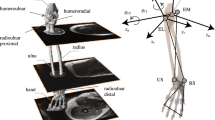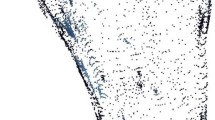Abstract
Muscle structure is an essential component in typical computational models of the musculoskeletal system. Almost all musculoskeletal models represent muscle geometry using a set of line segments. The straight-line approach limits models’ ability to accurately predict the paths of muscles with complex geometry. This approach needs knowledge of how the muscle changes shape and interacts with fundamental structures like muscles, bones, and joints that move. Moreover, the moment arms are supposed to be equivalent to all the fibers in the muscle. This study aims to create a shoulder musculoskeletal model that includes complex muscle geometries. We reconstructed the shape of fibers in the entire volume of six muscles adjacent to the shoulder using an automated technique. This method generates many fibers from the surface geometry of the skeletal muscle and its attachment areas. Highly discretized muscle representations for all muscles were created and used to simulate different shoulder movements. The moment arms of each muscle were calculated and validated against cadaveric measurements and models of the same muscles from the literature. We found that simulations using the developed musculoskeletal models generated more realistic geometries, which expands the physical representation of muscles compared to line segments. The shoulder musculoskeletal model with complex muscle geometry is created to increase the anatomical reality of models and the lines action of muscle fibers, and to be used for finite element investigations.







Similar content being viewed by others
References
Ackland, D. C., P. Pak, M. Richardson, and M. G. Pandy. Moment arms of the muscles crossing the anatomical shoulder. J. Anat. 213(4):383–390, 2008.
An, K. N., K. Takahashi, T. P. Harrigan, and E. Y. Chao. Determination of muscle orientations and moment arms. J. Biomech. Eng. 106:280–282, 1984.
Assila, N., S. Duprey, and M. Begon. Glenohumeral joint and muscles functions during a lifting task. J. Biomech. 126:110641, 2021.
Blemker, S. S., and S. L. Delp. Three-dimensional representation of complex muscle architectures and geometries. Ann. Biomed. Eng. 33:661–673, 2005.
Charlton, I. W., and G. R. Johnson. A model for the prediction of the forces at the glenohumeral joint. Inst. Mech. Eng. H. 220:801–812, 2015.
Damsgaard, M., J. Rasmussen, S. T. Christensen, E. Surma, and M. de Zee. Analysis of musculoskeletal systems in the AnyBody Modeling System. Simul. Model. Pract. Theory. 14:1100–1111, 2006.
Delp, S. L., F. C. Anderson, A. S. Arnold, P. Loan, A. Habib, C. T. John, E. Guendelman, and D. G. Thelen. OpenSim: open-source software to create and analyze dynamic simulations of movement. IEEE Trans. Biomed. Eng. 54:1940–1950, 2007.
Garner, B. A., and M. G. Pandy. A kinematic model of the upper limb based on the visible human project (VHP) image dataset. Comput. Methods Biomech. Biomed. Eng. 2:107–124, 1999.
Garner, B. A., and M. G. Pandy. The obstacle-set method for representing muscle paths in musculoskeletal models. Comput. Methods Biomech. Biomed. Eng. 3:1–30, 2000.
Hawkins, D., and A. Barr. A computational approach for simulating muscle morphologic changes in musculoskeletal modeling. Comput. Methods Biomech. Biomed. Eng. 4:399–411, 2001.
Hoffmann, M., D. Haering, and M. Begon. Comparison between line and surface mesh models to represent the rotator cuff muscle geometry in musculoskeletal models. Comput. Methods Biomech. Biomed. Eng. 20:1175–1181, 2017.
Holzbaur, K. R. S., W. M. Murray, and S. L. Delp. A model of the upper extremity for simulating musculoskeletal surgery and analyzing neuromuscular control. Ann. Biomed Eng. 33:829–840, 2005.
John, C. T. Complete Description of the Thelen2003Muscle Model. Stanford: OpenSim, 2011.
Kohout, J., and D. Cholt. Computer Methods and Programs in Biomedicine Automatic reconstruction of the muscle architecture from the superficial layer fibres data. Comput. Methods Programs Biomed. 150:85–95, 2017.
Kohout, J., G. J. Clapworthy, Y. Zhao, Y. Tao, F. Dong, H. Wei, and E. Kohoutova. Patient-specific fibre-based models of muscle wrapping. Interface Focus. 3:20120062, 2013.
Kohout, J., and M. Kukačka. Real-time modelling of fibrous muscle. Comput. Graph. Forum. 33:1–15, 2014.
Kuechle, D. K., S. R. Newman, E. Itoi, B. F. Morrey, and K. N. An. Shoulder muscle moment arms during horizontal flexion and elevation. J. Shoulder Elbow Surg. 6(5):429–439, 1997.
Kuechle, D. K., S. R. Newman, E. Itoi, G. L. Niebur, B. F. Morrey, and K. N. An. The relevance of the moment arm of shoulder muscles with respect to axial rotation of the glenohumeral joint in four positions. Clin. Biomech. 15:322–329, 2000.
Lang, A. E., J. H. Lin, and C. R. Dickerson. Activation patterns of shoulder internal and external rotators during pure axial moment generation across a postural range. J. Biomech.123:110503, 2021.
Lieber, R. L., and J. Fridén. Clinical significance of skeletal muscle architecture. Clin. Orthopaed. Relat. Res. 383:140–151, 2001.
Liu, J., R. E. Hughes, W. P. Smutz, G. Niebur, and K. Nan-An. Roles of deltoid and rotator cuff muscles in shoulder elevation. Clin. Biomech. 12:32–38, 1997.
Ludewig, P. M., V. Phadke, J. P. Braman, D. R. Hassett, C. J. Cieminski, and R. F. Laprade. Motion of the shoulder complex during multiplanar humeral elevation. J. Bone Jt. Surg. Ser. A. 91:378–389, 2009.
Mathai, B., and S. Gupta. Numerical predictions of hip joint and muscle forces during daily activities: A comparison of musculoskeletal models. Proc. Inst. Mech. Eng. 233:636–647, 2019.
Modenese, L., and J. Kohout. Automatic generation of personalised skeletal models of the lower limb from three-dimensional bone geometries. Ann. Biomed. Eng. 116:110186, 2020.
Mohr, A., and M. Gleicher. Building efficient, accurate character skins from examples. ACM Trans. Graph. 22(3):562–568, 2003.
Mulla, D. M., J. N. Hodder, M. R. Maly, J. L. Lyons, and P. J. Keir. Modeling the effects of musculoskeletal geometry on scapulohumeral muscle moment arms and lines of action. Comput. Methods Biomech. Biomed. Eng. 22:1311–1322, 2019.
Otis, J. C., C. C. Jiang, T. L. Wickiewicz, M. G. E. Peterson, R. F. Warren, and T. J. Santner. Changes in the moment arms of the rotator cuff and deltoid muscles with abduction and rotation. J. Bone Jt. Surg. 76:667–676, 1994.
Péan, F., C. Tanner, C. Gerber, and P. Fürnstahl. A comprehensive and volumetric musculoskeletal model for the dynamic simulation of the shoulder function. Comput. Methods Biomech. Biomed. Eng. 22:740–751, 2019.
Reilly, M., and K. Kontson. Computational musculoskeletal modeling of compensatory movements in the upper limb. J. Biomech.108:109843, 2020.
Saul, K. R., X. Hu, C. M. Goehler, M. E. Vidt, M. Daly, A. Velisar, and W. M. Murray. Benchmarking of dynamic simulation predictions in two software platforms using an upper limb musculoskeletal model. Comput. Methods Biomech. Biomed. Eng. 18:1445–1458, 2014.
Seth, A., M. Dong, R. Matias, and S. Delp. Muscle contributions to upper-extremity movement and work from a musculoskeletal model of the human shoulder. Front. Neurorobot. 13:90, 2019.
Seth, A., J. L. Hicks, T. K. Uchida, A. Habib, L. Dembia, J. J. Dunne, C. F. Ong, M. S. Demers, A. Rajagopal, M. Millard, S. R. Hamner, E. M. Arnold, R. Yong, S. K. Lakshmikanth, M. A. Sherman, J. P. Ku, and S. L. Delp. OpenSim: Simulating musculoskeletal dynamics and neuromuscular control to study human and animal movement. PLoS Comput. Biol. 14(7):e1006223–e1006224, 2018.
Seth, A., R. Matias, A. P. Veloso, and S. L. Delp. A biomechanical model of the scapulothoracic joint to accurately capture scapular kinematics during shoulder movements. PLoS ONE. 11:1–18, 2016.
Seth, A., M. Sherman, P. Eastman, and S. Delp. Minimal formulation of joint motion for biomechanisms. Nonlinear Dyn. 62:291–303, 2010. https://doi.org/10.1007/s11071-010-9717-3.
Valente, G., G. Crimi, N. Vanella, E. Schileo, and F. Taddei. NMSBUILDER: freeware to create subject-specific musculoskeletal models for OpenSim. Comput. Methods Prog. Biomed. 152:85–92, 2017.
Inman, V. T., J. D. M. Saunders, and L. C. Abbott. Observations of the function of the shoulder joint. J. Bone Jt. Surg. 26(1):1–30, 1944.
Webb, J. D., P. Taylor, S. S. Blemker, and S. L. Delp. 3D finite element models of shoulder muscles for computing lines of actions and moment arms. Comput. Methods Biomech. Biomed. Eng. 17(8):829–837, 2014.
Weinhandl, J. T., and H. J. Bennett. Musculoskeletal model choice influences hip joint load estimations during gait. J. Biomech. 91:124–132, 2019.
de Wilde, L., E. Audenaert, E. Barbaix, A. Audenaert, and K. Soudan. Consequences of deltoid muscle elongation on deltoid muscle performance: a computerised study. Clin. Biomech. 17:499–505, 2002.
Wu, G., F. C. T. van der Helm, H. E. J. Veeger, M. Makhsous, P. van Roy, C. Anglin, J. Nagels, A. R. Karduna, K. McQuade, X. Wang, F. W. Werner, and B. Buchholz. ISB recommendation on definitions of joint coordinate systems of various joints for the reporting of human joint motion—Part II: shoulder, elbow, wrist and hand. J. Biomech. 38:981–992, 2005.
Xiao, M., and J. Higginson. Sensitivity of estimated muscle force in forward simulation of normal walking. J. Appl. Biomech. 26(2):142–149, 2010.
Acknowledgments
The authors wish to thank the staff of the Mechanical System Design Laboratory-EMP.
Funding
The author(s) received no financial support for the research, authorship, and/or publication of this article.
Author information
Authors and Affiliations
Corresponding author
Ethics declarations
Conflict of interest
The author(s) declared no potential conflicts of interest with respect to the research, authorship, and/or publication of this article.
Additional information
Associate Editor Jillian Urban oversaw the review of this article.
Publisher's Note
Springer Nature remains neutral with regard to jurisdictional claims in published maps and institutional affiliations.
Supplementary Information
Below is the link to the electronic supplementary material.
Rights and permissions
Springer Nature or its licensor (e.g. a society or other partner) holds exclusive rights to this article under a publishing agreement with the author(s) or other rightsholder(s); author self-archiving of the accepted manuscript version of this article is solely governed by the terms of such publishing agreement and applicable law.
About this article
Cite this article
Kedadria, A., Benabid, Y., Remil, O. et al. A Shoulder Musculoskeletal Model with Three-Dimensional Complex Muscle Geometries. Ann Biomed Eng 51, 1079–1093 (2023). https://doi.org/10.1007/s10439-023-03189-y
Received:
Accepted:
Published:
Issue Date:
DOI: https://doi.org/10.1007/s10439-023-03189-y




